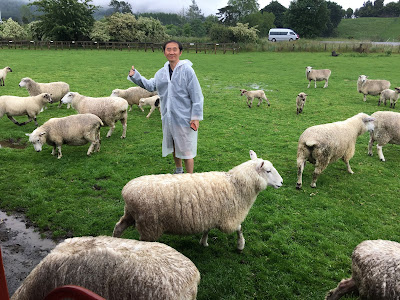We started off this rainy day at Agrodome Farm. At the junction before entering the car park, there is a statue of a majestic sheep, Merino.
We bought a Farm Show and Farm Tour combo family tickets. As it was still slightly early for the Farm Show, we visited the Farmyard nursery where we could cuddle cute baby animals.
When the legendary Agrodome Farm Show was about to start, we got ourselves seated and ready for a fun-packed hour of entertainment and education. During the show, we got to meet and learn about 19 breeds of sheep.
After which, there was a sheep shearing demonstration and followed by a live aunction.
As it was raining quite heavily, the dog trial demonstration, which was held outdoor, was cancelled. However we got to meet these amazing farm dogs during the show.
At the end of the show, we went on stage to take photos with the sheep and dogs.
When it was time for our Farm Tour, we climbed aboard an all-weather, purpose built farm vehicles. This was a one hour long guided tour of the farm, animals and the orchard.
During the tour, we had the opportunities to hand feed various animals, with the sheep being the first.
Next we arrived at the territory of llamas and alpacas.
This was our first time feeding the alpacas and llamas. At first glance, we could not differentiate between alpacas and llamas until the guide explained to us.
1) Alpaca ears have short spear-shaped ears while llamas have much longer, banana-shaped ears.
2) Alpacas generally weigh in at around 150 pounds while llamas can get as heavy as 400 pounds.
3) Llamas have a longer face while an alpaca’s face is a bit more blunt.
4) The alpaca produces a much finer fiber than the llama.
5) Alpacas are very much herd animals, while llamas are more independent minded.
At this point, we were supposed to have a spectacular view of a mountain but it was totally covered by the clouds.
We then explored the fruit orchard and sampled the farm's kiwifruit juice and honey. Do you know that Kiwifruit actually originate from China? The first seeds were brought out of China by missionaries to New Zealand at the turn of this century. Early nurserymen in New Zealand, such as Alexander Allison, Bruno Just, and Hayward Wright, recognized the potential of the fruit and it soon became a popular backyard vine.
We saw many other animals before returning back to the farm entrance.
Before alighting the vehicle, the guide passed an Emu egg around for us to hold and feel it.
It was still raining when we left the farm. As such, we decided to go for our lunch at a nearby mall till the rain got lighter.




































No comments:
Post a Comment